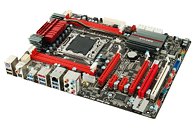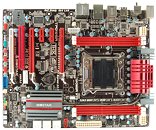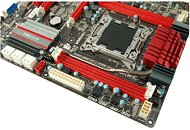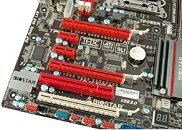Wednesday, November 2nd 2011

Biostar TPower Makes a Comeback with TPower X79, Geared for Extreme Overclocking
Biostar's coveted TPower brand makes a comeback with TPower X79, Biostar's premium overclocking motherboard for the Core i7 "Sandy Bridge-E" platform. TPower motherboards have been known to be a part of some record-setting CPU OC feats right from the days of LGA775. The TPower X79 is another product that's meant for record-setting feats, with its strong VRM and slim feature-set that does away with everything overclockers don't need and adds to the bloat of the motherboard.
The CPU is powered by an 8-phase DuraMax VRM with active phase control and direct FETs. It draws power from two 8-pin EPS connectors, apart from the 24-pin ATX and an optional 4-pin Molex for PCIe slot stability. Apart from a strong VRM, the board makes use of POSCAP capacitors in the CPU area, and a high-quality clock generator. The VRM and chipset heatsinks are connected with a 6 mm heat pipe, the heatsinks are made of a ceramic surface material for better dissipation. The CPU is wired to just four DDR3 DIMM slots, one per channel, which shouldn't be an issue for overclockers. It gives you shorter memory traces. Apart from JEDEC speeds of up to DDR3-1600 MHz, the board supports DDR3-2400 MHz by overclocking.Expansion slots include two PCI-Express 3.0 x16 (permanent x16), one PCI-Express 2.0 x16 (permanent x8, white), two PCIe x1, and a legacy PCI. Storage connectivity includes six SATA 6 Gb/s (two via X79 PCH, four via additional controllers), one (red) SATA 3 Gb/s from the PCH (for the optical drive), and an eSATA 3 Gb/s, also from the PCH. There are eight USB 3.0 ports on the board (six on the rear panel, two via header), all driven by 2-port controllers made by ASMedia. Other connectivity includes one gigabit Ethernet connection, and 8+2 channel HD audio. A nice cosmetic touch here is the EMI shield over the audio CODEC.
Source:
MyDrivers
The CPU is powered by an 8-phase DuraMax VRM with active phase control and direct FETs. It draws power from two 8-pin EPS connectors, apart from the 24-pin ATX and an optional 4-pin Molex for PCIe slot stability. Apart from a strong VRM, the board makes use of POSCAP capacitors in the CPU area, and a high-quality clock generator. The VRM and chipset heatsinks are connected with a 6 mm heat pipe, the heatsinks are made of a ceramic surface material for better dissipation. The CPU is wired to just four DDR3 DIMM slots, one per channel, which shouldn't be an issue for overclockers. It gives you shorter memory traces. Apart from JEDEC speeds of up to DDR3-1600 MHz, the board supports DDR3-2400 MHz by overclocking.Expansion slots include two PCI-Express 3.0 x16 (permanent x16), one PCI-Express 2.0 x16 (permanent x8, white), two PCIe x1, and a legacy PCI. Storage connectivity includes six SATA 6 Gb/s (two via X79 PCH, four via additional controllers), one (red) SATA 3 Gb/s from the PCH (for the optical drive), and an eSATA 3 Gb/s, also from the PCH. There are eight USB 3.0 ports on the board (six on the rear panel, two via header), all driven by 2-port controllers made by ASMedia. Other connectivity includes one gigabit Ethernet connection, and 8+2 channel HD audio. A nice cosmetic touch here is the EMI shield over the audio CODEC.




28 Comments on Biostar TPower Makes a Comeback with TPower X79, Geared for Extreme Overclocking
These are the generation motherboards that will be the base for Ivy Bridge as well right? We wont get X89 mobo's by that time?
Or are you guys expecting at least another small upgrade by that time?
The successor to this platform will be Ivy Bridge-E, and that's more than an year away. I expect a smooth upgrade path to Ivy Bridge-E from X79.
P.S. Here is the supposed roadmap if I remember things correctly:
SB (LGA 1155)---------->Ivy Bridge (LGA 1155, so backwards compatible with current motherboards)
LGA 1336 based platforms----------------->Sandy Bridge-E (LGA 2011). Not as much an upgrade as a replacement of the existing flagship platform by another one.
Also, I have an X58 and obviously lost out when SB came out as my upgrade path was limited. Do you expect IB-E to use the same socket as SB-E and if so is there any evidence?
Cheers :)
It's just the chipset (its storage controllers), and the first wave of LGA2011 boards will have the same SATA connectivity that P67/Z68/H67 gives you. The second wave of LGA2011 boards (maybe Spring 2012), could have a more feature-rich chipset.No, that's a common misconception. Intel marketing is placing Sandy Bridge-E as a HEDT (high-end desktop) product, occupying market segments above every other client processor (that's Performance2, Extreme 1 and Extreme 2).No, there is no evidence that Ivy Bridge-E even exists at this moment. Given that Sandy Bridge-E will be the fastest desktop platform for the foreseeable future, and given that Intel streamlined Sandy Bridge and Ivy Bridge to at least have a common platform (LGA1155, conditional, though compatible), everyone expects Sandy Bridge-E successor to be a LGA2011 chip based on the 22 nm Ivy Bridge architecture (to at least benefit from the 22 nm process, and try to increase clock speeds).
In other words: just buy it, mate! :)
Ivy Bridge maybe'll be not faster then Sandy-E but it will be more affordable i reckon, also I expect overclockable processors at in my eyes a lot more acceptable TDP's
I wont be buying a new motherboard till Ivy Bridge is actually among us, but I just wanted to know if there are any current fully supporting mobo's coming out already so i can start dreaming and drooling all over em and start planning my rig...
The only parts i currently own of my new system are the case and the vid card.
I could always buy one in January..... (and I live in Glasgow - those highland folk are a bit wierd).
And FTR, I run a Biostar T-Power X58 and it's a cracking board.
Anyhoe I did some googling, and there will be new motherboards for Ivy Bridge, so I guess it would be logical to wait for those ;)
LOL.
I should get a sample of this board.
Bit of a shame really. ( only a bit)
This is not a Evga SR2 / SR3 but would do for most people.
LOL ASSMedia is making usb3.0 controllers, are they paper square based media on a roll or "silly-cone" ?
Does it need a B type plug ?
How can they be 2 ports or is it some special version running 6 ports, maybe some groupy thing ?
Not into this so no idea how it works.
Surely it would be sold with the new thermal ky jelly or at least have some vaseline based thermal paste for lubrication and friction control ?
Between T-power and Assmedia someone designing this must have been a bit frustrated or had a "bone" to pick with someone else.
Wink wink nudge nudge. :roll: